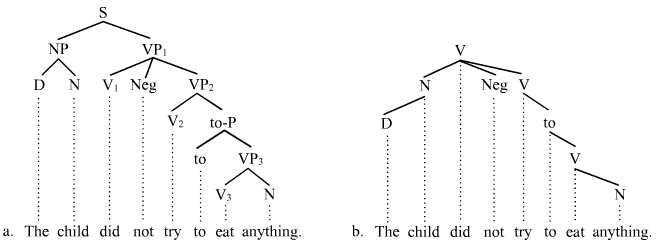Branching
shape of the parse trees that represent the structure of sentences From Wikipedia, the free encyclopedia
Remove ads
Branching is a term in linguistics. It refers to the way a phrase or sentence is made up. There is a head word and various other words to make the phrase or sentence.
Examples
Most languages make phrases with a head word and dependents (modifiers). These examples show the phrase heads in bold.
Examples of left-branching phrases (= head-final phrases):
- the house - Noun phrase (NP)
- very happy - Adjective phrase (AP)
- too slowly - Adverb phrase (AdvP)
Examples of right-branching phrases (= head-initial phrases):
- laugh loudly - Verb phrase (VP)
- with luck - Prepositional phrase (PP)
- that it happened - Subordinator phrase (SP = subordinate clause)
Example of phrases that contain both left- and right-branching (= head-medial phrases):
- the house there - Noun phrase (NP)
- very happy with it - Adjective phrase (AP)
- only laugh loudly - Verb phrase (VP)
Most structures in English are, however, not completely left- or completely right-branching, but rather they combine both. The following trees show a combination of left- and right-branching in English:
There are more right-branching structures than left-branching structures in English. This means that trees usually grow down to the right.
Remove ads
Wikiwand - on
Seamless Wikipedia browsing. On steroids.
Remove ads
